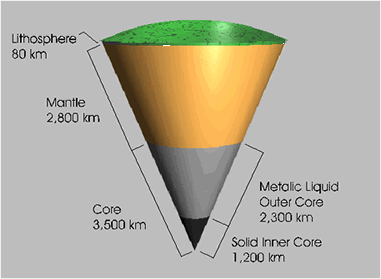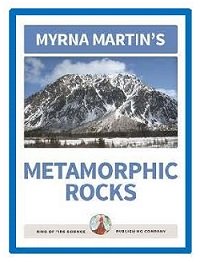Layers in the Mantle
Beneath Earth's crust is the Mantle
Boundary between the crust and the mantle
The Earth's mantle lies beneath the crust. The boundary between the crust and the mantle was discovered by Andre Mohorovicic, a Croatian seismologist. The boundary is deeper under the continents that it is under the ocean floors. Mohorovicic discovered the Mohorovicic Discontinuity (Moho boundary) when he looked at the speed earthquake waves travel inside the body of the Earth.

Major layers inside the Earth, USGS
Density changes at Moho boundary
Moho boundary
At the Moho boundary between the Earth's mantle and the crust the density of the rock changes from 2.9 grams per cubic centimeter to 3.4 grams per cubic centimeter. The increase in density causes an increase in the speed that p waves travel through the body of the earth. The waves are also slightly deflected by the change in density of the rocks at the boundary.


Click for More Information and to Order
Upper mantle rocks
Mantle and crustal rocks
Mantle and crustal rocks have different mineral compositions. Typical rocks found in the mantle have more magnesium and iron than crustal rocks. Peridotite is the dominant rock of the upper mantle.
Common minerals
Minerals commonly found in the rocks include olivine, pyroxene and garnets. The crust has a variety of igneous, sedimentary and metamorphic rocks that are lighter and less dense than peridotite.
Minerals in the mantle
Olivine, pyroxene and garnet minerals
Olivine, pyroxene and garnet minerals are found in rocks from the Moho boundary to a depth of 410 kilometers. Between 400 kilometers and 650 kilometers beneath the Earth's surface the minerals are under so much heat and pressure they become unstable.
Minerals recrystallize
The minerals recrystallize into minerals that are stable at this heat and pressure without melting. Below 650 kilometers all the minerals become unstable and the rocks melt when they reach the Earth's outer core.
Temperature and pressure in the mantle
Temperature in the mantle
The upper mantle has a temperature range between 500 degrees and 900 degrees Celsius near the crust. Deep in the Earth at the boundary with the Earth's core the rock temperature is about 4000 degrees Celsius.
Pressure in the mantle and outer core
Only the extreme pressure keeps the rocks in the mantle from melting. At the boundary between the mantle and the outer core the rocks melt and become molten.
KIDS FUN Science Bookstore
Check out Myrna Martin's award winning textbooks, e-books, videos and rock sets. The Kids Fun Science Bookstore covers a wide range of earth science topics. Click here to browse.










